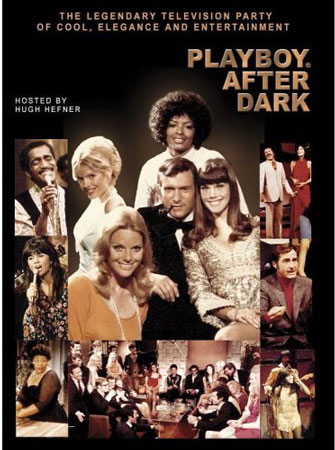 The letter from Playboy’s Home Entertainment Division that accompanied my copy of the three-DVD set Playboy After Dark read:
The letter from Playboy’s Home Entertainment Division that accompanied my copy of the three-DVD set Playboy After Dark read:
“Grammy! Here is your sophisticated entertainment. I hope the lack of cumshots isn’t disappointing.”
Is that what you people think of me?
I dimly remember repeats of Playboy After Dark, Hugh Hefner’s “rumpus room party” from the late 60’s and early 70’s, and I don’t remember its predecessor by ten years, Playboy’s Penthouse. Both featured a Cy Coleman opening score that sounded, a propos of the period, like a combination of Neil Hefti’s “The Odd Couple” theme (only divorced men can appreciate being playboys) and the theme from “Route 66”.
Watching both black and white Penthouses on Disc 1, I was amazed at what TV audiences were given credit for in those days, not only in content but in length. An interview with Lenny Bruce, in which the comic compared Beatniks to rabbis, lasted a whopping 15 minutes.
All the while drink is flowing and people are smoking up a storm. Hef hosts the show, and in a 2006 interview he recalls the pipe and the smoking jacket as part of his reinvention of himself. Jazz music also played a large part in this “…for a kid who grew up as I did in which the music represented a kind of a freedom and sophistication which I didn’t have.”
Hefner called the girls-in-ball-dresses, smart-men-in-suits-and-ties scenario of Playboy’s Penthouse “the dream of the 40’s and 50’s.” It really does look like a glimpse into the fantasies of one’s bachelor uncles. There is no sex, and hardly any innuendo, but the Playmates are more seen than heard, long-legged ornaments for the space-age bachelor pad, delivering drinks to people like Bruce, Nat King Cole, and Cy Coleman’s Trio. The girls gamely follow along as the men talk, listening attentively.

Hefner is a nervous host in the early series. He mentions starting Playboy magazine with no money, and he has a certain new-money awkwardness, and sometimes a trace of condescension, when talking with his guests, as if they shouldn’t forget who is paying for the party.
On the other hand, people like Bruce display a fawningness to Hefner that I would not have expected, repeatedly complimenting Hef on the show. I would probably do the same thing. Each guest appears amazed that actual liquor is being served.
Bruce is a little uncomfortable performing in a clean, well-lit room, as if money makes him nervous. Hef has the money, and he struggles to appear urbane. They both act as if they’re not quite in the right place, but the show works.
Bruce recounts threatening to walk off a television show because producers had a problem with his material.
“I’ve got enough bread,” he said, “I’m not gonna make this scene.” Hef smokes his pipe, thinking, “I’ve got my own show.”
To hear the conversation, to watch that generation’s aspirations for itself, as well as to view standout performances by guests Sammy Davis Jr., Coleman, and Ella Fitzgerald is worth more than a History Channel marathon.

The next two discs deal with Playboy After Dark. Filmed in color, Hef is now in his early 40’s and has been “Mr. Playboy” for 15 years. It is the end of the 60’s and the women are in miniskirts and the men (except for the musicians) are still in suits. As Wooderson said in Dazed And Confused, “I get older, they stay the same age.”
The first of the Playboy After Dark discs opens with a game of Simon Says. Part of the Playboy ideal at that point, as manifested by Hef himself, is staying young or, more to the point, recapturing youth. Hef does this when he meets Barbi Benton (then Barbara Klein) on set. At the time she is 24. Throughout the rest of the series, she is on his arm, listening attentively.
 Both series reflected a leftist aesthetic with clear aspirations to establishment legitimacy. This is why guest Mort Sahl could talk about championing “the left” while drinking with Playmates in a multimillion-dollar penthouse set.
Both series reflected a leftist aesthetic with clear aspirations to establishment legitimacy. This is why guest Mort Sahl could talk about championing “the left” while drinking with Playmates in a multimillion-dollar penthouse set.
“1969 was a year in which if a man tried to collect his thoughts he’d be arrested for unlawful assembly,” Sahl said to the collected Republicans, who laughed like Sahl was a delightful pet.
 Excellent performances by Linda Ronstadt, Sonny And Cher, Canned Heat, and Joe Cocker are featured in the Playboy After Dark discs, and Sonny and Cher are particularly envious of Hef’s jet, which they’d only heard about.
Excellent performances by Linda Ronstadt, Sonny And Cher, Canned Heat, and Joe Cocker are featured in the Playboy After Dark discs, and Sonny and Cher are particularly envious of Hef’s jet, which they’d only heard about.
“Does it really have smoked glass in the back?” they ask.
“We worry about peeping toms up there,” Hef replies.
People say that science fiction says more about the time it was made than the time it seeks to depict. Playboy’s world of the 60’s, coinciding with the Civil Rights Movement, the Great Society, and the Sexual Revolution, reflects Hef’s reinvention of himself in a world that’s all about class.
- Buy the DVD set here.
Previously: 35 years of grass on the field; Gram Ponante sold to Playboy



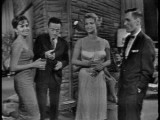
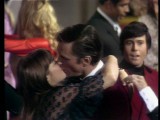
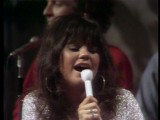
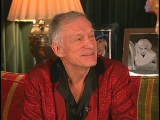
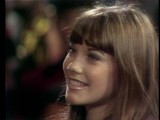
Robert Evans is The Kid, but Hugh Hefner is The MAC.